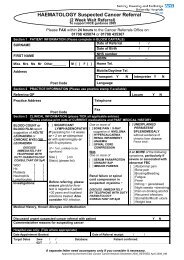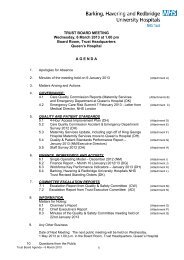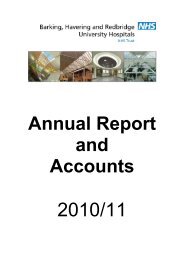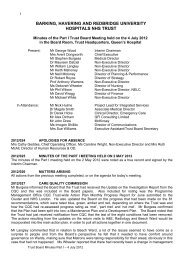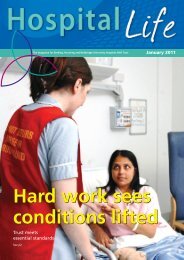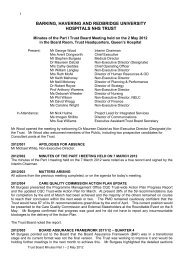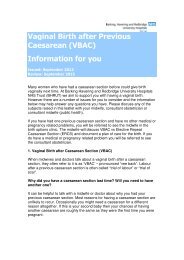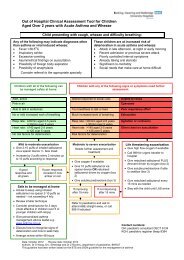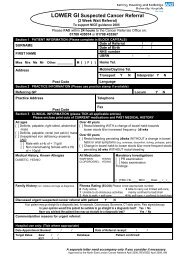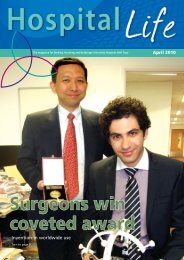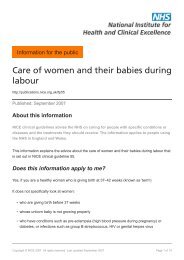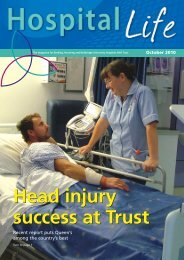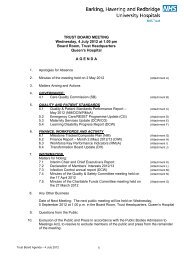BHRUT annual report 2009 - Barking Havering and Redbridge ...
BHRUT annual report 2009 - Barking Havering and Redbridge ...
BHRUT annual report 2009 - Barking Havering and Redbridge ...
Create successful ePaper yourself
Turn your PDF publications into a flip-book with our unique Google optimized e-Paper software.
44<br />
<strong>Barking</strong>, <strong>Havering</strong> & <strong>Redbridge</strong> University Hospitals NHS Trust<br />
charged to the revaluation reserve to the extent that<br />
there is a balance on the reserve for the asset <strong>and</strong>,<br />
thereafter, to expenditure. Gains <strong>and</strong> losses<br />
recognised in the revaluation reserve are <strong>report</strong>ed as<br />
other comprehensive income in the Statement of<br />
Comprehensive Income.<br />
Subsequent expenditure<br />
Where subsequent expenditure enhances an asset<br />
beyond its original specification, the directly<br />
attributable cost is capitalised. Where subsequent<br />
expenditure restores the asset to its original<br />
specification, the expenditure is capitalised <strong>and</strong> any<br />
existing carrying value of the item replaced is writtenout<br />
<strong>and</strong> charged to operating expenses.<br />
1.10 Intangible assets<br />
Recognition<br />
Intangible assets are non-monetary assets without<br />
physical substance, which are capable of sale<br />
separately from the rest of the trust’s business or<br />
which arise from contractual or other legal rights.<br />
They are recognised only when it is probable that<br />
future economic benefits will flow to, or service<br />
potential be provided to, the trust; where the cost of<br />
the asset can be measured reliably, <strong>and</strong> where the cost<br />
is at least £5000.<br />
Intangible assets acquired separately are initially<br />
recognised at fair value. Software that is integral to<br />
the operating of hardware, for example an operating<br />
system, is capitalised as part of the relevant item of<br />
property, plant <strong>and</strong> equipment. Software that is not<br />
integral to the operation of hardware, for example<br />
application software, is capitalised as an intangible<br />
asset. Expenditure on research is not capitalised: it is<br />
recognised as an operating expense in the period in<br />
which it is incurred. Internally-generated assets are<br />
recognised if, <strong>and</strong> only if, all of the following have<br />
been demonstrated:<br />
• the technical feasibility of completing the intangible<br />
asset so that it will be available for use<br />
• the intention to complete the intangible asset <strong>and</strong><br />
use it<br />
• the ability to sell or use the intangible asset<br />
• how the intangible asset will generate probable<br />
future economic benefits or service potential<br />
• the availability of adequate technical, financial <strong>and</strong><br />
other resources to complete the intangible asset<br />
<strong>and</strong> sell or use it<br />
• the ability to measure reliably the expenditure<br />
attributable to the intangible asset during its<br />
development<br />
Measurement<br />
The amount initially recognised for internallygenerated<br />
intangible assets is the sum of the<br />
expenditure incurred from the date when the criteria<br />
above are initially met. Where no internally-generated<br />
intangible asset can be recognised, the expenditure is<br />
recognised in the period in which it is incurred.<br />
Following initial recognition, intangible assets are<br />
carried at fair value by reference to an active market,<br />
or, where no active market exists, at amortised<br />
replacement cost (modern equivalent assets basis),<br />
indexed for relevant price increases, as a proxy for fair<br />
value. Internally-developed software is held at historic<br />
cost to reflect the opposing effects of increases in<br />
development costs <strong>and</strong> technological advances.<br />
1.11 Depreciation, amortisation <strong>and</strong><br />
impairments<br />
Freehold l<strong>and</strong>, properties under construction, <strong>and</strong><br />
assets held for sale are not depreciated.<br />
Otherwise, depreciation <strong>and</strong> amortisation are charged<br />
to write off the costs or valuation of property, plant<br />
<strong>and</strong> equipment <strong>and</strong> intangible non-current assets, less<br />
any residual value, over their estimated useful lives, in<br />
a manner that reflects the consumption of economic<br />
benefits or service potential of the assets. The<br />
estimated useful life of an asset is the period over<br />
which the Trust expects to obtain economic benefits<br />
or service potential from the asset. This is specific to<br />
the Trust <strong>and</strong> may be shorter than the physical life of<br />
the asset itself. Estimated useful lives <strong>and</strong> residual<br />
values are reviewed each year end, with the effect of<br />
Annual Accounts



![[4] Biopsy Leaflet.pub - Barking, Havering and Redbridge University ...](https://img.yumpu.com/51285530/1/190x134/4-biopsy-leafletpub-barking-havering-and-redbridge-university-.jpg?quality=85)

